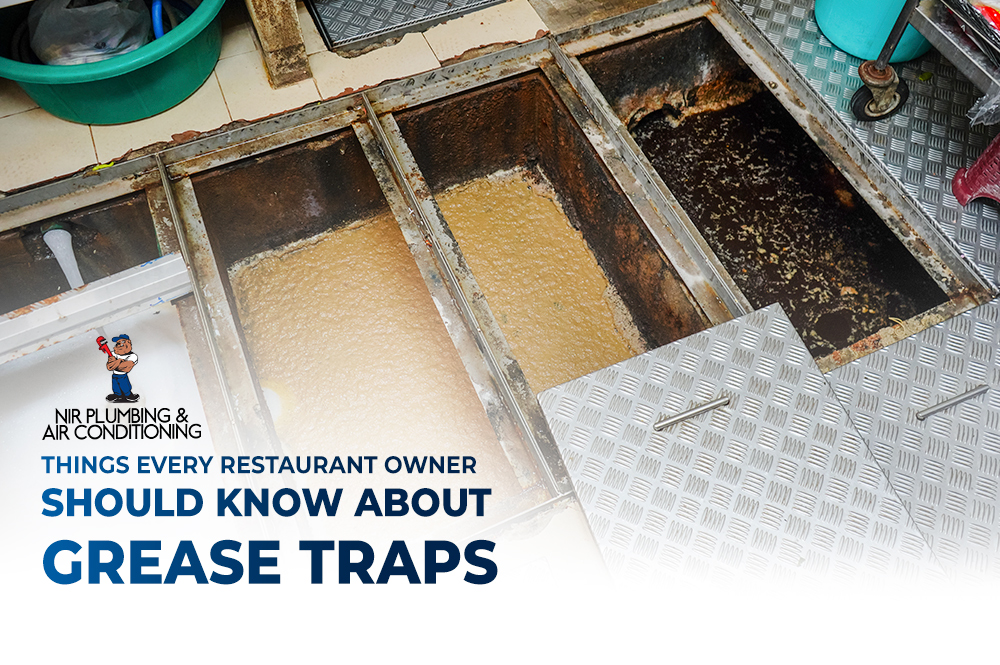Overview: A restaurant’s grease trap might go unnoticed, but they’re bound to fail every once in a while. Every commercial kitchen is required to operate and maintain grease traps to prevent blockages. We have rounded up some things you should know about grease traps!
A grease trap is a must-have device for a restaurant, for both practical and legal reasons. You might not think much about it on a day-to-day basis, but it’s important to remember that it’s there and it requires some regular TLC.
If you’re an experienced restaurant owner, you probably know all about grease traps, but maybe you could use a refresher. If you’re a new or aspiring restaurant owner, it’s a good idea to familiarize yourself with what they are and how to maintain them.
To put it simply, a grease trap is exactly what it sounds like: a device that’s installed in the plumbing system of a kitchen that prevents harmful grease from entering the local sewer system when it goes down the drain. Essentially, the purpose of a grease trap is to get dirty, so they require periodic cleaning to keep them functioning.
Failing to clean your grease traps could leave you figuratively ankle-deep in regret — and literally ankle-deep in food waste. If your grease trap goes overlooked, you could end up in big trouble with a sewer backup. So why not take steps at your restaurant to prevent a problem before it happens?
To keep your restaurant’s kitchen running smoothly and cleanly, we’ve rounded up some tips and tricks to help you maintain your grease traps and prevent unfortunate and expensive mishaps.
Understanding Grease Traps:
An integral part of municipal codes is the inspection and maintenance of grease traps. These codes apply to any facility that prepares food with the potential for fatty waste draining to the local sewage system from drains near sinks, food prep areas, dish-washing areas, or other compartments. Such facilities are required to install these grease traps as a way to capture the grease before it enters the public sewer system and creates a big mess for everyone out there.
Related Reading: Here’s what to do when your dishwasher doesn’t drain
When food grease cools down, it becomes a wax-like substance that can adhere to different surfaces. If the waste continues to build up, it can eventually lead to massive blockages in the sewage system, resulting in thousands of dollars of repairs. Since restaurants and bars are large grease producers, they’re expected to capture it before it enters the public sewer system. To avoid getting into trouble, consult your local city or county code to ascertain the location and placement of grease traps in your establishments.
A grease trap typically works using two chambers: the first is to hold the grease, allowing it to solidify. Eventually, the material floats to the top of the trap, letting water and other non-greasy liquids pass into the sewage system. Then there’s a tube that connects both chambers. The remaining water from the first chamber is transferred into the second chamber, leaving the greasy substances behind.
Related Reading: 5 things you may not know about your restaurant grease trap
Prevention Measures:
We believe prevention is better than a cure – so the best way to prevent a sewer backup is by ensuring proper maintenance. However, you can only change a system if you know it inside out. A few steps that restaurant owners may take to keep oil and grease flowing freely through their pipes include:
Locate the grease trap: That will sound obvious, but you can only begin the cleaning process if you know where the grease trap is located. The most likely place to find grease traps is near a dishwasher or a sink, or near drains where food deposits and grease go down. Often, the grease trap is located outside a restaurant, near the pipes connecting the facility to the outside sewer system. If you need help locating grease traps, you might want to ask a professional plumber for assistance.
Clean the grease trap: While some grease interceptors recommend cleaning grease traps once every week, the truth is that this isn’t a realistic scenario for a restaurant. Grease traps in restaurants should be checked once a week and cleaned once a month. If you find your grease trap even a quarter full of buildup, clean it ASAP, so it doesn’t cause a sewer backup in the near future!
What to Do if the Grease Trap Overflows
If one of your grease traps overflows and backs up into your kitchen, the first thing you should do is: stay calm. There are several measures you can take to fix the issue.
Here are a few quick tips for you:
-
Stop any additional water from flowing into the kitchen drains.
-
Call a professional plumber to inspect your commercial building drainage system.
-
Though it may be tempting, don’t pull out the hose to spray the greasy waste into the storm sewers.
-
Use cat litter to absorb the spilled grease (it sounds strange but it really works!).
Professional plumbers use high-tech equipment to inspect plumbing pipes. They’ll take a look and let you know when the lines are clear of grease, or if the waste requires a thorough cleaning.
Related Reading: Why is my grease trap overflowing?
How to Keep Your Grease Trap Working Properly:
The easiest way to prevent a messy backup is to have your grease traps serviced and inspected regularly. If you’re new to the business and need some pointers on how to look after your grease traps, we’re happy to review your kitchen habits and help you stay on track with best practices against grease and waste removal.
Here are some things to remember:
-
Make sure that any sinks associated with the food prep process are connected to a trap.
-
Train your kitchen staff to dump food waste from pans into a trash receptacle — not down the drain.
-
Ensure your trap is the right size for your business.
If you’d like more information about grease traps, don’t hesitate to contact us today and request a commercial service quote.
Related Reading: Everyday prevention maintenance tips for your grease traps
In Summary:
Despite what the song says, “grease” is not the word for a restaurant owner. If you ignore your grease trap, chances are you’re going to have a huge, messy problem on your hands. A grease trap problem could force you to close your restaurant temporarily, and cost you lots of money in cleanup costs and lost revenue. Not to mention the potential health risk to your employees.
Maintaining the grease trap in your restaurant — or any similar food-based establishment — should be a part of your routine maintenance checklist. If you keep the aforementioned tips in mind, you should be in good shape.
For assistance with your pipes, or answers to any plumbing questions that require a professional perspective, get in touch with us today!


